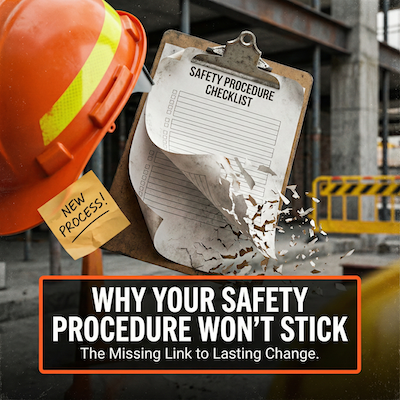Safety is crucial in any industry, particularly in high-risk sectors such as construction, manufacturing, and logistics. Despite the advances in technology and stringent regulations, workplace accidents still occur, raising the question - are we approaching safety the right way?
In this post, we'll take a closer look at two innovative methods, Scratchie and iCARE, that are humanising safety in a bid to minimise risks and accidents. We'll also draw insights from Dr Robert Long, an expert in social psychology, to understand the significance of humanised safety strategies.
The Conventional Approach to Safety
Traditionally, safety management strategies have leaned heavily towards bureaucratic systems, implementing rules and regulations that workers must follow to maintain a safe work environment. While these systems are necessary and have undoubtedly saved lives, they have significant limitations.
These strategies often overlook the fact that safety is not just about compliance with checklists and matrices, but about people. As Dr Robert Long, a leading figure in the field of social psychology, rightly points out, people are subject to biases and social influences that impact judgment, decision-making, and risk management in the workplace. He argues that risk assessment should be based on people as the most crucial aspect of the workplace. By focusing solely on rigid systems and rules, traditional safety approaches can fail to account for the human element and the complex social influences at play.

This is where the need for innovative, people-centered safety strategies comes in. In order to truly improve safety and risk analysis, a more comprehensive approach is needed. Dr Long suggests involving a diverse range of professionals, including social scientists, lawyers, engineers, and human factors specialists. This approach can help to better understand the complexities of human behaviour and the social psychology of risk, leading to more effective safety strategies.
Humanising Safety with iCARE
One company that embodies this philosophy of focusing on people and simplifying safety is the iCARE Safety Group. For over three decades, iCARE has been leading the way in creating innovative safety solutions for businesses worldwide, making safety both effective and meaningful for their people.
At the heart of iCARE's philosophy is the belief in humanising safety. They aim to streamline safety systems, build leadership skills, and nurture safety cultures that align values and strengthen relationships. This approach resonates strongly with Dr Long's emphasis on the importance of considering social influences and biases in safety management. By promoting meaningful communication and connecting people to the very purpose of safety, iCARE is taking significant strides towards humanising safety.

An example of iCARE's approach in action can be seen in their work with MEO Group, a Singapore-based company providing specialised marine services. iCARE conducted a full safety systems review for MEO, aligning the corporate systems with those used for offshore vessels. They spent significant time understanding the maritime challenges and risks associated with major offshore oil and gas companies. By gathering information and developing efficient strategies accepted by the people offshore, iCARE successfully revised MEO's Safety Management System, which continues to evolve and function effectively today.
This case study underscores the importance of a people-focused approach to safety, as advocated by both iCARE and Dr Long. Rather than relying solely on regulations and checklists, it highlights the significance of understanding the unique challenges faced by workers and developing safety strategies that genuinely connect with them.
Scratchie: A New Take on Safety
Innovation in safety management doesn't stop at simplifying systems and humanising safety practices. Another innovative approach comes from an Australian app called Scratchie, which is reinventing safety through positive reinforcement.
Scratchie’s approach is unique and refreshing. Rather than focusing solely on rules and regulations, Scratchie incentivises safe behaviour through rewards. This aligns with Dr. Long's philosophy of focusing on people, understanding their motivations, and influencing their behaviour positively.

Scratchie allows supervisors to issue on-the-spot rewards to workers who demonstrate a positive safety attitude. The rewards are categorised based on specific safety activities, which enables decision-makers to promote particular behaviours they wish to encourage. This approach is a significant shift from traditional safety management strategies that often involve punitive measures for safety infractions. By providing immediate positive reinforcement, Scratchie motivates workers to be more engaged and safety-conscious.
The Power of Positive Reinforcement
Psychologists agree that for a reward to influence behaviour effectively, it needs to be “temporally adjacent” to the said activity - meaning it needs to occur as soon after the desired behaviour is demonstrated. Scratchie’s immediate, on-the-spot rewards align perfectly with this principle, making it a potent tool in promoting safe behaviours.
The app doesn't just reward safe behaviour - it also collects crucial lead-indicator data, recording who is rewarded, for what behaviour, by whom, and when. This aggregated data can provide meaningful safety lead indicators, shedding light on safety trends within the organisation and offering insights into areas that need attention.
Scratchie also brings an element of gamification to safety management. By making safety a positive and rewarding experience rather than a "necessary evil," Scratchie contributes to a more engaged and safety-conscious workforce.
Scratchie in Action
To understand how Scratchie works in real-life scenarios, let's consider an example. A construction supervisor sees a worker maintaining a tidy workspace without being asked. The supervisor opens the Scratchie app, selects the "Tidiness" award category, and presents a QR code to the worker, who scans it with their own Scratchie app. After a brief countdown, the reward is issued, which can be immediately claimed and transferred to the worker's bank account.

This system of immediate reward not only encourages the worker to maintain a tidy workspace but also encourages others who witness the reward to do the same. By recognising and rewarding positive safety behaviours in real-time, Scratchie effectively encourages workers to internalise these behaviours, promoting a culture of safety within the workplace.
Scratchie's innovative approach is already being used by major Australian builders such as Laing O'Rourke, John Holland, and Richard Crookes. As the company expands into new markets and industries, it has the potential to significantly transform how safety is managed and perceived.
iCARE and Scratchie: United in Innovation
Two distinct yet complementary approaches to safety management, iCARE's emphasis on simplifying and humanising safety and Scratchie's unique system of rewarding positive safety behaviour both reflect a shift in the safety industry. This shift is towards a more person-centred and less bureaucratically-bound system, reminiscent of Dr. Long’s assertion that people cannot be forced into compliance through bureaucratic systems alone.
The strategies employed by iCARE and Scratchie not only address the issues at hand but also tackle underlying resistance to safety functions. By simplifying safety systems and promoting meaningful communication, iCARE connects people to the very purpose of safety. Simultaneously, Scratchie motivates and engages workers through positive reinforcement, encouraging a proactive safety culture.
The Impact of Humanising Safety
By humanising safety, both iCARE and Scratchie are paving the way for a more effective, efficient, and emotionally intelligent approach to safety management. By acknowledging the individuality and humanity of workers, these innovative approaches create a more engaging and fulfilling safety culture.
An example of the impact of humanising safety can be seen in a case study involving MEO Group and iCARE. MEO Group enlisted iCARE to conduct a full safety systems review. The goal was to align the corporate systems with those used for offshore vessels. Using a deeply personalised and meticulous approach, iCARE delivered a fully revised Safety Management System that is still evolving and helping MEO Group maintain its commitment to operational and safety excellence.
Conclusion: The Future of Safety
The future of safety lies in innovation and personalisation. As Dr. Long argues, risk assessment should be based on people as the most important aspect of the workplace. By simplifying and humanising safety, companies like iCARE and Scratchie are not just improving safety; they are changing how people 'feel' about their safety.
These innovative approaches show us that safety is not just about systems or rules. It's about creating an environment where people feel valued, understood, and motivated to contribute to a culture of safety. By focusing on the human aspect of safety, we can transform safety from a bureaucratic necessity into a meaningful and engaging part of our work culture.
As we continue to innovate and learn, it's essential to remember that at the heart of every safety strategy should be a profound respect for human lives and well-being. After all, safety is not just about reducing accidents; it's about creating an environment where every individual can thrive.










.svg)
